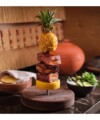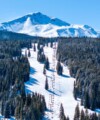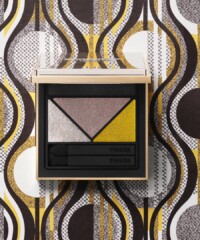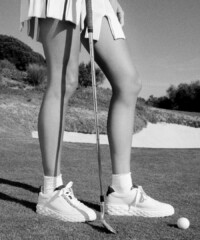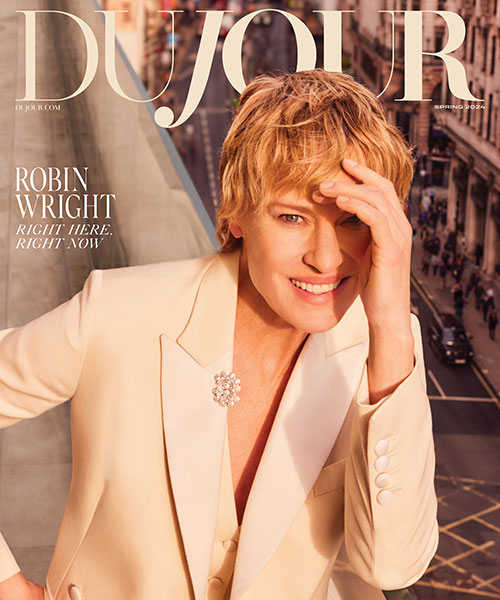“I’ve always done what’s on my mind,” says David LaChapelle, recalling a vision that came to him two and a half years ago on his farm in eastern Maui. “An image popped into my head—I saw this glowing gas station in the jungle at night.” Though he didn’t know why he was doing it at the time, LaChapelle set about manifesting this imagined gas station (Gas BP, 2013, pictured below) via painted corrugated cardboard, LED lights and various reflective materials sourced from the local 99-cent store. “At first I just thought it was enchanting looking; the original idea was about an archaeologist from a millenium beyond stumbling upon the ruins of an ancient civilization.” But headlines about climate change of peak oil sent his mind racing in a new direction.

Gas BP, 2013, chromogenic print, 50 x 79 inches; image courtesy of the artist and Paul Kasmin Gallery
“Where I live in Hawaii it’s pristine and you almost forget there’s all these problems in the world until you look at the news.” On the heels of his luscious 2005 krumping documentary Rize, LaChapelle retired from celebrity and fashion photography—he famously shot Lil’ Kim with Louis Vuitton-logoed skin and Amanda Lepore snorting lines of diamonds—and took over a former nudist colony in Hana, situated in the middle of Hawaii state park land. There he lives off-the-grid, raising organic fruits and vegetables.

David LaChapelle; photo by Garret Suhrie
Since that early gas station project, LaChapelle has constructed three more stations, six refineries, and a nuclear power planet—hewn from found objects like salvaged tea canisters, bucket loads of glitter, even fishnet-clad bowling balls—for his latest exhibition, Land Scape, opening tonight at Paul Kasmin Gallery.
Of course, this isn’t LaChapelle’s first foray into environmentalist-tinged imagery. His last fashion assignment for Italian Vogue, The House at the End of the World, featured models in elaborate couture Prada and Viktor & Rolf gowns heaving sandbags to one another before houses from the War of the Worlds backlot set, all meant to evoke a hurricane. As luck would have it, the issue was published when Katrina hit, and LaChapelle was labeled as “insensitive.” Though, in fact, his utilization of the post-storm motif was a response to his mother’s constant plight, living in Florida’s “Hurricane Alley.”
Channeling that same purity of purpose, LaChapelle began constructing pieces like his towering chartreuse-tinged Emerald City from what he calls “the ingredients of our lives”—tin cans and Day-Glo mixing cups, plastic baseball bats and those stocking-wrapped bowling balls. “A lot of them are taken from the
memory of seeing refineries when I was a kid and how they intrigued me,” he says. “I remember going past this one with my parents, we were going through Buffalo on a summer road trip and I remember saying, ‘Whoa, the lights.’ They looked so beautiful like an emerald city.”
While he shot the Gas Station series in the tropical forest by his farm, LaChapelle captured his ruby-glittered Kings Dominion diorama (pictured right) in the Joshua Tree desert and situated the Pacific Sunset piece (a tableaux of reel-to-reel players, circuitry, aluminum cooking tray smokestacks and Japanese green tea canisters) on a Malibu cliff overlooking the ocean. Meanwhile, otherworldly pieces like Riverside (pictured below) were shot in the studio. With its proliferation of Rock Star Energy Drink cans—”a different kind of energy” as LaChapelle observed during a preview of the show—serving as functional water features the artifice speaks for itself.

Riverside, 2013, chromogenic print, 72 x 93 3/8 inches; image courtesy of the artist and Paul Kasmin Gallery
“It’s all fueled by oil—that’s one reason for using these materials. The other is just to engage the viewer,” says LaChapelle, acknowledging the art world subversion of potentially placing one of these works in the collections of an energy broker or oil industrialist.
“There’s a conscious decision to attract, not repel, people even when talking about subject matter that can get very heavy. Maybe later they can understand the reasons behind these and connect with them on some level and they can resonate with that. That’s the beauty of art. To me that’s when it’s complete, when somebody comprehends or feels what I was trying to express.”
If only he’d made them pre-Enron.

Green Fields, 2013, chromogenic print, 72 x 74 5/8 inches; image courtesy of the artist and Paul Kasmin Gallery

Gas 76, 2013, chromogenic print, 50 x 66 3/4 inches; image courtesy of the artist and Paul Kasmin Gallery

Gas Am Pm, 2013, chromogenic print, 50 x 72 3/16 inches; image courtesy of the artist and Paul Kasmin Gallery
Land Scape opens January 17 at the Paul Kasmin Gallery and runs through March 1, 2014.
MORE:
Isabella Rossellini Adapts Green Porno to the Stage
Rediscovering Postmodern Art with Peter Shire
Pop Artist Robert Indiana Is Back



